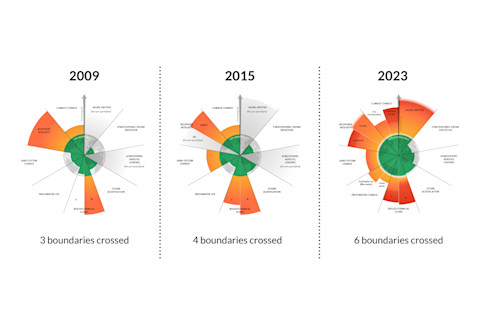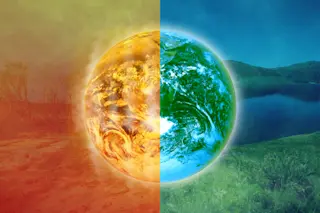Earth is a complicated planet, with a huge number of complex processes working together to make the place livable for humans and every other organism. Since the industrial revolution began — and perhaps earlier — humans have been changing many of these components directly by removing resources like stored carbon or fresh water from the system or indirectly by releasing wasteful byproducts such as aerosols, carbon dioxide and other kinds of pollution.
Earth scientists have broken down the major components that make our planet livable into a framework of nine planetary boundaries. Any of these boundaries, including climate and biodiversity, could drastically change the conditions that have made our species thrive on Earth for the past 10,000 years if exceeded.
“It would then be foolish for humanity to knowingly do something to trigger a state change in the conditions we have here,” says Katherine Richardson, a biological oceanographer at the University of Copenhagen’s Sustainability Science Center. “You need some guardrails, and that’s what planetary boundaries are all about.”
What Are Planetary Boundaries?
Planetary boundaries are a concept introduced in the field of Earth system science to define a safe operating space for humanity within which we can thrive and maintain a stable environment.

(Credit: Avigator Fortuner/Shutterstock)
Avigator Fortuner/Shutterstock
They represent a set of critical environmental and ecological thresholds or limits that, if crossed or exceeded, could lead to abrupt and irreversible changes in Earth's system, potentially posing severe risks to human civilization. A group of scientists led by Johan Rockström and Will Steffen first proposed the concept in 2009.
Read More: 4 Ways Climate Change Is Already Taking a Toll
Nine Planetary Boundaries
Earth’s climate has been stable because of the stability of nine planetary boundaries. The main two boundaries are climate and biosphere integrity (a boundary that includes biodiversity) — humans can affect these two directly, but the other seven boundaries can also impact these main two.

(Credit:Carrie Webster/Shutterstock)
The remaining seven are air pollution, ocean acidification, ozone depletion, freshwater availability, land use, nutrient pollution and human pollution. The boundaries represent points at which human activity is causing major effects on the world in each of these categories.
Read More: What Is Smog, and What Have We Done to Improve Air Quality?
What Is the Planetary Boundaries Framework?
The planetary boundaries framework is based on the idea that the past 10 millennia have seen a particularly stable climate for humans.
Richardson and her colleagues have been using the nine planetary boundaries framework to track the broad-scale changes humans are causing to our planet since 2009 when they first published a study describing them.

(Credit: Azote for Stockholm Resilience Centre, based on analysis in Richardson et al 2023)
Azote for Stockholm Resilience Centre, based on analysis in Richardson et al 2023
The fact that humans first developed complex civilizations during this period is no coincidence, Richardson says. These conditions are critical for everything from agriculture to abundant ocean resources.
Read More: 5 Examples of the Worst Human-Made Disasters in History
How Many Planetary Boundaries Have Been Crossed?
In a study recently published in Science Advances updating the state of our planet according to this framework, Richardson’s team found that humans have exceeded six of the nine of these boundaries.
The boundaries we have crossed are climate, biosphere integrity, freshwater availability, land use change, nutrient pollution and human pollution.

The evolution of the planetary boundaries framework. (Credit: Credit: Azote for Stockholm Resilience Centre, Stockholm University. Based on Richardson et al. 2023, Steffen et al. 2015, and Rockström et al. 2009).
Credit: Azote for Stockholm Resilience Centre, Stockholm University. Based on Richardson et al. 2023, Steffen et al. 2015, and Rockström et al. 2009
Crossing any one of these isn’t necessarily something we can’t recover from, Richardson says. The ozone depletion boundary, for example, has been crossed before, but global action to ban aerosols like chlorofluorocarbons (CFCs) has reversed ozone depletion greatly — today, ozone depletion is one of the three boundaries not currently crossed.
“We really dodged a bullet there,” Richardson says.
She is most concerned about the lack of progress in recent years in some of the other categories. “What’s scary is that the ones we’ve crossed back in 2015 are still crossed in 2023,” she says.
Read More: How the Ozone Layer Evolved and Why It's Important
What Are Examples of Planetary Boundaries?
Examples include the drainage of fresh water from rivers and underground aquifers. Nutrient pollution like phosphorus and nitrogen in rivers is increasing due to their use in fertilizer. These substances can prompt an explosion of sometimes toxic cyanobacteria, which can kill organisms and deplete the water of oxygen, creating dead zones in lakes and oceans.

(Credit:Ethan Daniels/Shutterstock)
The biosphere integrity has been seriously compromised by what some biologists call the sixth global extinction event — a massive kill-off of the world’s organisms due to a number of factors, including habitat loss, pollution, indiscriminate hunting and the spread of invasive species.
Chemical pollution is also something getting worse in many cases. While governments have banned things like CFCs and bromides that deplete the ozone layer, other problems like PFAS, the so-called forever chemicals, are still being released in massive quantities.
“We’re throwing them out into the environment without even testing — we’re playing a game of Russian roulette,” Richardson says.
Read More: How Climate Change Threatens Drinking Water Quality
Will We Cross a Seventh Boundary?
One of the three boundaries not currently exceeded — that of ocean acidification — may soon be crossed due to the excessive release of carbon dioxide in the atmosphere. Industry is partly responsible for releasing CO2, but the removal of much of the world’s forest land means that there are fewer trees to absorb the extra gas.

Aerial photo of deforestation from logging in the Malaysia rainforest. (Credit: Rich Carey/Shutterstock)
Rich Carey/Shutterstock
For now, the only other boundary that’s relatively safe, Richardson says, is that of aerosols in the atmosphere. Governments have managed to keep this under control in many cases, not due to the overall damage it does to the workings of our planet, but because polluted air has a direct negative effect on human health.
Read More: We've Lost 35 Percent of Forests in the Past 300 Years
What Are the Challenges of the Planetary Boundaries Framework?
Overall, this framework is a moving target as scientists learn more about how to measure the various factors that affect the behavior of our planet. In 2015, for example, it appeared we had only crossed four of the boundaries. But better science in 2023 revealed we had crossed another two prior to 2015, Richardson says.
While governments play a large role in controlling these major factors, Richardson says it depends on everyone to want to make a difference. “Part of the challenge is understanding the mess that we’re in,” she says.
Resource consumption — especially by rich, developed countries — is largely unsustainable. “If everyone lived in the same way — used the same resources that Americans do — we would need four planets,” Richardson says, likening the situation of our planet to a decreasing lifestyle budget. “You can continue to party even if the balance of your bank account is going down, but you can’t party forever.”
Read More: How Does Climate Change Affect Human Health?















